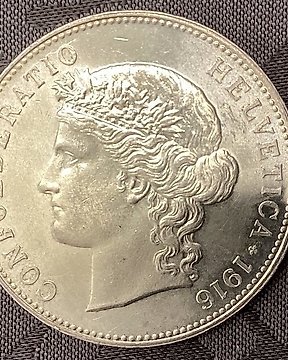
Suisse. Eidgenossenschaft. 5 Franken 1916 B, Bern. R
Nº 83175587

Nº 83175587

KM# 37 5 FRANCS 1923 B
25.00 g., 0.900 Silver 0.7234 oz. ASW, 37 mm. Obv: William Tell right Rev: Shield �anked by sprigs
Please have a look at our other Catawiki auction lots for more coin collections. and/or add us to your favourites to find our future auction lots easily.
Bid with confidence. AG-Worldcoins, over 3000 lots sold on Catawiki. High feedback score.
Please evaluate this lot with reference to the images provided.
Will be sent via registered mail.
I charge only 1x shipping costs when you buy multiple lots in the same auction.
You are welcome to bid on my other items:
https://veiling.catawiki.nl/aanbod/hamaca
extra info:
The Swiss Confederation, located in central Europe north of Italy and south of Germany, has an area of 15,941 sq. mi. (41,290 sq. km.. Capital: Bern. The economy centers about a well developed manufacturing industry. Machinery, chemicals, watches and clocks, and textiles are exported.
Switzerland, the habitat of lake dwellers in prehistoric times, was peopled by the Celtic Helvetians when Julius Caesar made it a part of the Roman Empire in 58 B.C. After the decline of Rome, Switzerland was invaded by Teutonic tribes, who established small temporal holdings which in the Middle Ages, became a federation of fiefs of the Holy Roman Empire. As a nation, Switzerland originated in 1291 when the districts of Nidwalden, Schwyz and Uri united to defeat Austria and attain independence as the Swiss Confederation. After acquiring new cantons in the 14th century, Switzerland was made independent from the Holy Roman Empire by the 1648 Treaty of Westphalia. The revolutionary armies of Napoleonic France occupied Switzerland and set up the Helvetian Republic, 1798-1803. After the fall of Napoleon, the Congress of Vienna, 1815, recognized the independence of Switzerland and guaranteed its neutrality. The Swiss Constitutions of 1848 and 1874 established a union modeled upon that of the United States.
MINT MARKS
B - Bern
BA - Basel
BB - Strasbourg S – Solothurn
NOTE: The coinage of Switzerland has been struck at the Bern Mint since 1853 with a few exceptions. All coins minted there carry a B mint mark through 1969, and from 1986 to date. All Swiss coins minted from 1970 through 1985 were also struck by the Bern Mint but without the B mint mark. The 1968 and 1969 coins without the B mint mark were struck by the British Royal Mint in London. The two exceptions to the foregoing are: Some of the 1969 1 Franc coins with the B mint mark and some of the 1970 1⁄2 Franc coins without the B mint mark were struck by the British Royal Mint in London.
Comment acheter sur Catawiki ?
1. Découvrez des objets d’exception
2. Faites la meilleure offre
3. Effectuez un paiement sécurisé